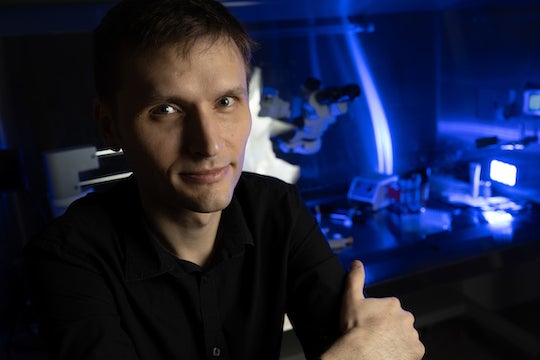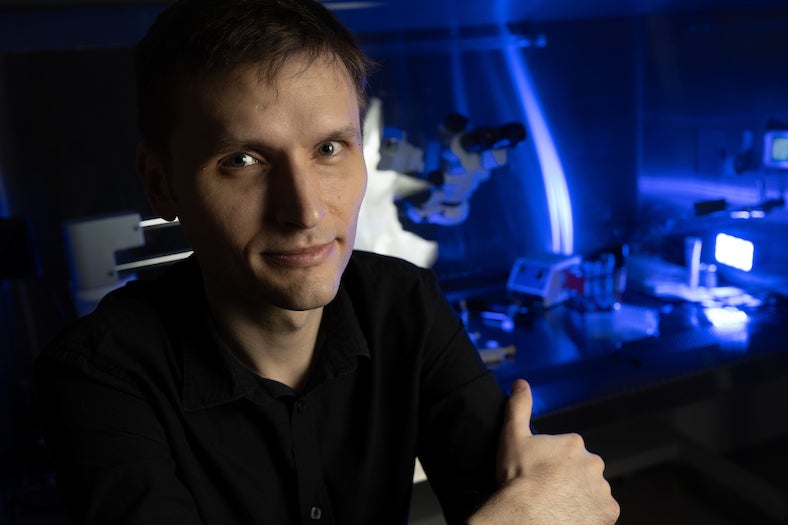Rice University bioengineer Jerzy Szablowski has won a prestigious Young Faculty Award from the Defense Advanced Research Projects Agency (DARPA) to identify nongenetic drugs that can temporarily enhance the human body’s resilience to extreme cold exposure.

Szablowski, an assistant professor of bioengineering at Rice’s George R. Brown School of Engineering, plans to deploy a new screening method to find drugs capable of enhancing the cold adaptation response of brown adipose tissue (BAT), or brown fat, which regulates body temperature by breaking down blood sugar and other fat molecules in a process known as thermogenesis. The human body’s response to cold involves two types of thermogenesis.
“One involves shivering, which all of us have experienced,” Szablowski explained. “If you are getting ill and you are developing a fever, you begin to shiver, and that shivering raises your body temperature. The problem is that you lose dexterity and it is really unpleasant.
“The other type of thermogenesis involves BAT, which is capable of generating heat through a chemical reaction,” he said. “Nonshivering thermogenesis kicks in sooner but is not as efficient, so it cannot generate quite as much heat, at least not in humans.”
Through the DARPA award, Szablowski will work with Miao-Hsueh Chen, an associate professor of pediatric nutrition at Baylor College of Medicine and an expert on BAT, to enhance nonshivering thermogenesis. A drug that boosts BAT response could help first responders treat victims of hypothermia and even lower the cost of arctic exploration.
“If you have a drug that makes brown fat more active, then instead of having to spend weeks and weeks adapting to cold, you can perform better within hours,” he said.
Szablowski said the new screening method could also be applied to optimize the development of drugs to treat diseases and infections, a process that is currently both cost- and time-consuming.
Drug development involves multiple stages, each of which requires specific resources and expertise. “First, you have to understand the biology of the disease or physiological process, and then find a site to intervene, like a protein or a process in the cell that you can target with a drug,” said Szablowski, who is a core faculty member in the Rice Neuroengineering Initiative. “This is where this project comes in. The main innovation of this screening method is that it is mechanism-agnostic, meaning that we might not need to fully understand the disease or physiological process before developing mitigation strategies.
“Simply put, it would allow us to screen a very large number of drugs,” he said.
-30-
High-resolution IMAGES are available for download at:
https://news-network.rice.edu/news/files/2023/01/Jerzy_portrait_LG.jpg
CAPTION: Jerzy Szablowski (Photo by Jeff Fitlow/Rice University)
Related stories:
Rice bioengineer seeks better signals from cells:
https://news.rice.edu/news/2022/rice-bioengineer-seeks-better-signals-cells
Packard Foundation backs Rice bioengineer:
https://news.rice.edu/news/2021/packard-foundation-backs-rice-bioengineer
Brain-to-brain communication demo receives DARPA funding:
https://eceweb.rice.edu/news/brain-brain-communication-demo-receives-darpa-funding
'Smart' wound-healing patch: DARPA awards $22 million grant:
https://news.rice.edu/news/2020/smart-wound-healing-patch-darpa-awards-22-million-grant
Links:
Laboratory for Noninvasive Neuroengineering (Szablowski lab):https://www.szablowskilab.org/
Rice Neuroengineering Initiative: https://neuroengineering.rice.edu/
Department of Bioengineering: https://bioengineering.rice.edu
George R. Brown School of Engineering: https://engineering.rice.edu
This release can be found online at news.rice.edu.
Follow Rice News and Media Relations via Twitter @RiceUNews.
Located on a 300-acre forested campus in Houston, Rice University is consistently ranked among the nation’s top 20 universities by U.S. News & World Report. Rice has highly respected schools of Architecture, Business, Continuing Studies, Engineering, Humanities, Music, Natural Sciences and Social Sciences and is home to the Baker Institute for Public Policy. With 4,240 undergraduates and 3,972 graduate students, Rice’s undergraduate student-to-faculty ratio is just under 6-to-1. Its residential college system builds close-knit communities and lifelong friendships, just one reason why Rice is ranked No. 1 for lots of race/class interaction and No. 1 for quality of life by the Princeton Review. Rice is also rated as a best value among private universities by Kiplinger’s Personal Finance.

